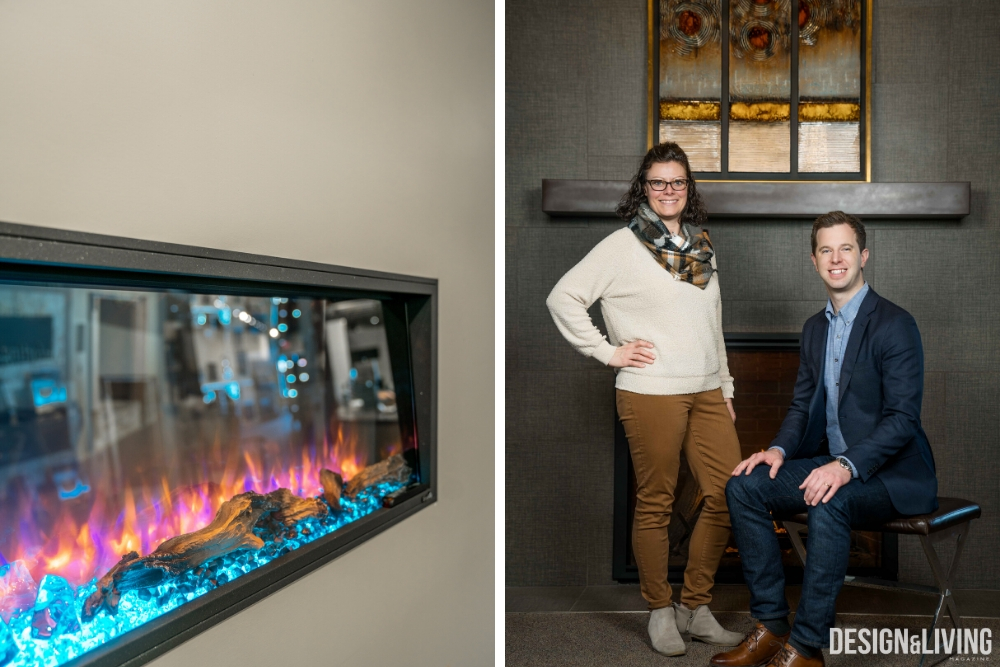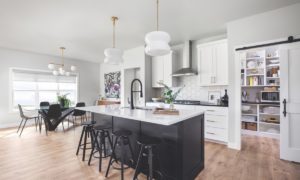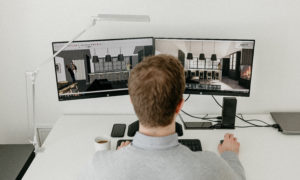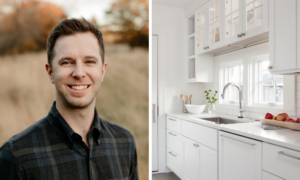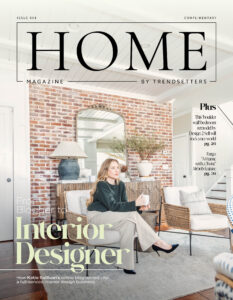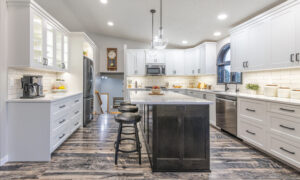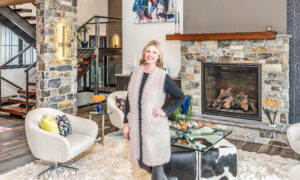Photos by Hillary Ehlen
When starting a home design, one of the first things that crosses my mind is where to locate the fireplace (especially this time of year). Does it sit across the room from the range hood with beam work tying the two together? Does a two-sided fireplace separate the living from the dining spaces? How does the TV relate to the fireplace — above or beside? There is always an opportunity for a fireplace to interact with a home’s layout to enhance the experience of our daily lives.
Historically, fireplaces were used out of necessity—to warm the home or cook— but today most are designed to provide a visual focal point. Whether you’re sitting next to one, or can simply see the glimmer from the next room, the feeling of a fireplace burning in your home provides an experience that cannot be rivaled. Although the style of the fireplace may be the first thing you notice, there are many things to consider before you’re ready to start the fire. Burning type (wood, gas, electric), room size, style and clearances are some of the crucial factors that need to work together to provide the homeowner with the experience they desire. Zenegra http://valleyofthesunpharmacy.com/zenegra/
When planning for a specialty item, like a fireplace, we like to engage the expertise of local professionals to ensure we are not missing any crucial details, such as ensuring the unit is appropriately sized for the space or coordinating the venting and clearances per the fireplace manufacturer. Darla Skaurud, the General Manager at Home & Hearth, is one the local professionals we often engage with to ensure we are on the right track. “Homeowners come in and they aren’t aware there are so many differences between fireplaces. We ask if they will be using the fireplace more for looks or more for heat? Are they looking for a more modern or a more traditional fireplace? Are they planning to put a TV above it? If there will be a TV above, we recommend fireplaces with lower mantel clearance to prevent the TV from getting too high. Asking these questions helps us narrow down which fireplaces to show them,” said Skaurud.

Fireplace Type & Size
Homeowners usually have strong feelings on whether they prefer wood-burning, gas or electric. Some won’t settle for anything other than a real wood-burning fire, even if it takes more time and effort, others prioritize time and efficiency, preferring gas, while others opt for the ease of the install and budget the electric option offers. You will want to select a unit that fits with the aesthetic of the space. Often linear units lend themselves to modern spaces, whereas taller, rectangular units lend themselves to more traditional spaces. Buy Generic Viagra
Regardless of the style, we study the massing and size of the fireplace with the scale of the room, ensuring the proportions complement each other. When the proportions and scale are appropriate, you can wrap the massing with any material and not compromise the design. These are the details that architects review to ensure the final product and overall space feel right.

In The Details
While selecting the unit may feel like the finish line, most units offer many additional options to choose from: fronts/doors, interior panels, LED lighting and even some with Bluetooth speakers. Our initial thought process regarding options is, when in doubt, keep it simple! We try to simplify the fireplace unit and let the surrounding materials provide the design. We feel that many simple elements should add up to form the full picture, rather than each element competing for attention.
One element that is often present in fireplace design, but overlooked, is the mantle. “A lot of times, people don’t realize they should have a mantle between the fireplace and the TV (if the TV is above the fireplace). TVs make their own heat, and don’t like heat—no electronics really do. The fireplace puts out great heat, heat rises and the TV is usually above it, so by putting the mantle there, it takes the brunt of the heat and deflects it from the television,” she said. Regarding proper clearances, Darla explained that she often likes to draw the proposed fireplace design in front of the client, asking for their ideal TV height and working with dimensions from there. Similar to Darla’s approach, we draw the fireplace elevation, detailing the exact materials, dimensions and clearances, often taking it even a step further by providing a 3D model that will allow the client to see exactly what will be built.

Size of Space
Always ensure the fireplace unit that was selected is not only aesthetically fitting, but more importantly appropriate for the size of the space, as we have had homeowners revise their fireplace selection based on the size of the space that will be heated. “The common question is ‘how big of a room are you looking to heat?’ Are you wanting it more for heat or for looks? Is it in the basement or on the main floor? Basements are tough to keep warm here in the winter, but on the main floor, not so much,” said Darla. “I often tell customers I would rather see you purchase a fireplace too small, allowing you to use it frequently, versus something too big, and you need to turn it off after a short period of time. We definitely want people to use their fireplace.”

Making the Choice
“Do the research, visit the showroom and stand in front of the fireplaces, get an idea of what ceramic glass versus tempered glass feels like, look at the options. Design the fireplace wall first, or have an idea of how you want the wall to look, and whether you’re going to put the TV above it or not.” Darla laughed, “We’re thankful for Pinterest, Houzz, architects and designers.”
When planning a fireplace for your project, we feel it is worth your time to engage a fireplace professional, an architect or both. We can help ensure that you love your final product, both in design and heat output, and you can trust the important specifics of venting and clearances have been coordinated.

Compare the options and what is important to you:
- Wood Burning: Takes more time and effort, but provides and authentic and cozy fireplace experience. Be sure you’re ready to supply firewood and be ready to clean up the ash residue. However, the payoff is the sound of the crackling fire and the highly desired smell of a warm fire.
- Gas: Gas fireplaces are time-efficient with instant satisfaction, as you can switch them on and get a fire immediately. They are also energy-efficient, as they can heat a whole space, if placed right. However, if you don’t already have a gas line installed, you’ll have to include that into the installation costs.
- Electric: Electric fireplaces are the least expensive option and the easiest to install. However, the look and feel aren’t as authentic and the “flame” is more obviously artificial. The impact of an electric fireplace is on par with a space heater and works better for smaller spaces. Installation by a licensed professional isn’t required, saving you on installation costs.
Strom Architecture
stromarch.com


